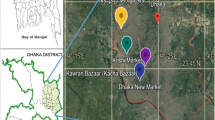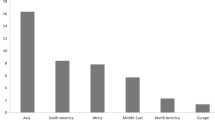Abstract
This study investigates the concentration of transition metals in imported and local rice brands on sale in some Ghanaian markets and the biochemical influences on the health of the Ghanaian population. A comparative analysis with previous studies in Ghana reveals that levels of Fe (3.64–4.44 mg/kg), Cd (0.03 mg/kg) and Cu (14.07–38.13 mg/kg) in the current study are much lower than the 13.67–21.35, 1.67–3.01, and 14.07–38.13 mg/kg recorded for Fe, Cd, and Cu, respectively. Rice sold in the Ghanaian markets contained different transition metals of which some are essential (Zn, Cu, Mn, and Fe). The levels of transition metals, such as Mn, Zn, Cd, Cu, and Fe are in moderate concentrations, which are well within the maximum acceptable limit of the World Health Organization. This study has revealed that R5 and R9 from the USA and India, respectively, recorded hazard indices above the safe limit of 1 and can therefore have the potential to pose detrimental health complications to consumers in the long term.


Similar content being viewed by others
Data availability
Data is available upon request from the authors.
References
Al-Saleh, I., & Shinwari, N. (2001). Report on the levels of cadmium, lead, and mercury in imported rice grain samples. Biological Trace Element Research, 83(1), 91–96.
Arnich, N., Sirot, V., Rivière, G., Jean, J., Noël, L., Guérin, T., & Leblanc, J. C. (2012). Dietary exposure to trace elements and health risk assessment in the 2nd French Total Diet Study. Food and Chemical Toxicology, 50(7), 2432–2449. https://doi.org/10.1016/j.fct.2012.04.016
Arredondo, M., & Núñez, M. T. (2005). Iron and copper metabolism. Molecular Aspects of Medicine, 26(4–5), 313–327.
Ayangbenro, A. S., & Babalola, O. O. (2017). A new strategy for heavy metal polluted environments: A review of microbial biosorbents. International Journal of Environmental Research and Public Health, 14(1), 94.
Baghaie, A., & Aghili, F. (2018). Evaluation of lead and cadmium concentration of Arak City soil and their non-cancer risk assessment in 2017. Journal of Rafsanjan University of Medical Sciences, 17(8), 769–780.
Berg, J. M. (1994). Principles of bioinorganic chemistry. University Science Books.
Brill, A. S. (1977). Transition metals in biochemistry. Springer Verlag.
Coughlan, M. (1983). The role of molybdenum in human biology. Journal of Inherited Metabolic Disease, 6, 70–77.
Cui, Z., Bai, K., Wang, X., Li, E., & Zheng, J. (2020). Electronic, magnetism, and optical properties of transition metals adsorbed g-GaN. Physica e: Low-Dimensional Systems and Nanostructures, 118, 113871.
Darko, G., Azanu, D., & Logo, N. K. (2016). Accumulation of toxic metals in fish raised from sewage-fed aquaculture and estimated health risks associated with their consumption. Cogent Environmental Science, 2(1), 1190116.
Dawe, D. (2013). Geographic determinants of rice self-sufficiency in Southeast Asia.
EFSA. (2013). Scientific opinion on dietary reference values for manganese (Vol. 11).
Engwa, G. A., Ferdinand, P. U., Nwalo, F. N., & Unachukwu, M. N. (2019). Mechanism and health effects of heavy metal toxicity in humans. Poisoning in the Modern World-New Tricks for an Old Dog, 10, 70–90.
Fu, J., Zhou, Q., Liu, J., Liu, W., Wang, T., Zhang, Q., & Jiang, G. (2008). High levels of heavy metals in rice (Oryzasativa L.) from a typical E-waste recycling area in southeast China and its potential risk to human health. Chemosphere, 71(7), 1269–1275.
Fukagawa, N. K., & Ziska, L. H. (2019). Rice: Importance for global nutrition. Journal of Nutritional Science and Vitaminology, 65(Supplement), S2-s3. https://doi.org/10.3177/jnsv.65.S2
Guengerich, F. P. (2009). Thematic series: Metals in biology. Journal of Biological Chemistry, 284(2), 709.
Hambidge, K. M., & Krebs, N. F. (2007). Zinc deficiency: A special challenge. The Journal of Nutrition, 137(4), 1101–1105.
Harmanescu, M., Alda, L. M., Bordean, D. M., Gogoasa, I., & Gergen, I. (2011). Heavy metals health risk assessment for population via consumption of vegetables grown in old mining area; A case study: Banat County. Romania. Chemistry Central Journal, 5(1), 1–10.
Horiguchi et al. (2004). Dietary exposure to cadmium at close to the current provisional tolerable weekly intake does not affect renal function among female Japanese farmers. Environmental Research, 95(1), 20–31. https://doi.org/10.1016/S0013-9351(03)00142-7
Huang, Z. L., & Failla, M. L. (2000). Copper deficiency suppresses effector activities of differentiated U937 cells. The Journal of Nutrition, 130(6), 1536–1542.
Ihedioha, J. N., Ujam, O. T., Nwuche, C. O., Ekere, N. R., & Chime, C. C. (2016). Assessment of heavy metal contamination of rice grains (Oryza sativa) and soil from Ada field, Enugu, Nigeria: Estimating the human healtrisk. Human and Ecological Risk Assessment: An International Journal, 22(8), 1665–1677.
Jonmaire, P. (2015). Molybdenum. Hamilton & Hardy's Industrial Toxicology, 167–172.
Lucca, P., Hurrell, R., & Potrykus, I. (2002). Fighting iron deficiency anemia with iron-rich rice. Journal of the American College of Nutrition, 21(sup3), 184S-190S.
Mbatchou, V. C., & Dawda, S. (2013). The nutritional composition of four rice varieties grown and used in different food preparations in Kassena-Nankana district. Ghana. Int. J. Res. Chem. Environ, 3(1), 308–315.
Nduka, J. K., Kelle, H. I., & Amuka, J. O. (2019). Health risk assessment of cadmium, chromium and nickel from car paint dust from used automobiles at auto-panel workshops in Nigeria. Toxicology Reports, 6, 449–456. https://doi.org/10.1016/j.toxrep.2019.05.007
Novotny, J. A. (2011). Molybdenum nutriture in humans. Journal of Evidence-Based Complementary & Alternative Medicine, 16(3), 164–168.
Onakpa, M. M., Njan, A. A., & Kalu, O. C. (2018). A review of heavy metal contamination of food crops in Nigeria. Annals of Global Health, 84(3), 488.
Onyedikachi, U. B., Belonwu, D. C., & Wegwu, M. O. (2018). Human health risk assessment of heavy metals in soils and commonly consumed food crops from quarry sites located at Isiagwu. Ebonyi State. Ovidius Univ. Ann. Chem, 29, 8–24.
Park, J. (2012). ZhengW. Human exposure and health effects of inorganic and elemental mercury. Journal of Preventative Medicine and Public Health, 45, 344–352.
Pauling, L. (1988). General chemistry. Courier Corporation. Dover Publications: New York
Rahman, et al. (2014a). Heavy metals in Australian grown and imported rice and vegetables on sale in Australia: Health hazard. Ecotoxicology and Environmental Safety, 100, 53–60.
Rahman, M., Hossain, M., Chowdhury, I. F., Matin, M., & Mehraj, H. (2014b). Variability study of advanced fine rice with correlation, path co-efficient analysis of yield and yield contributing characters. International Journal of Applied Sciences and Biotechnology, 2(3), 364–370.
Rodwell, V. W., Bender, D. A., Botham, K. M., Kennelly, P. J., & Weil, P. A. (2018). Harper's illustrated biochemistry. McGraw-Hill Education New York, NY, USA.
Roychowdhury, T., Tokunaga, H., & Ando, M. (2003). Survey of arsenic and other heavy metals in food composites and drinking water and estimation of dietary intake by the villagers from an arsenic-affected area of West Bengal. India. Science of the Total Environment, 308(1–3), 15–35.
Russell, R., Beard, J. L., Cousins, R. J., Dunn, J. T., Ferland, G., Hambidge, K., & Stoecker, B. (2001). Dietary reference intakes for vitamin A, vitamin K, arsenic, boron, chromium, copper, iodine, iron, manganese, molybdenum, nickel, silicon, vanadium, and zinc. A report of the panel on micronutrients, subcommittees on upper reference levels of nutrients and of interpretation and uses of dietary reference intakes, and the standing committee on the scientific evaluation of dietary reference intakes food and nutrition board Institute of medicine, 797.
Santamaria, A. B., & Sulsky, S. I. (2010). Risk assessment of an essential element: Manganese. Journal of Toxicology and Environmental Health, Part A, 73(2–3), 128–155.
Schroeder, H. A., Balassa, J. J., & Tipton, I. H. (1970). Essential trace metals in man: Molybdenum. Journal of Chronic Diseases, 23(7), 481–499. https://doi.org/10.1016/0021-9681(70)90056-1
Sharma, A. D. (2007). Relationship between nickel allergy and diet. Indian Journal of Dermatology, Venereology, and Leprology, 73(5), 307.
Singh, J. (2015). International conference on harmonization of technical requirements for registration of pharmaceuticals for human use. Journal of Pharmacology and Pharmacotherapeutics, 6, 185–187.
Singh, M., Garg, V., Gautam, Y., & Kumar, A. (2014). Soil to grain transfer factors of heavy metals in rice and health risk analysis in the vicinity of Narora Atomic Power Station (NAPS). Narora.
Tao, F., Zhang, Z., Shi, W., Liu, Y., Xiao, D., Zhang, S., & Liu, F. (2013). Single rice growth period was prolonged by cultivars shifts, but yield was damaged by climate change during 1981–2009 in China, and late rice was just opposite. Global Change Biology, 19(10), 3200–3209.
Tapiero, H., & Tew, K. D. (2003). Trace elements in human physiology and pathology: Zinc and metallothioneins. Biomedicine and Pharmacotherapy, 57(9), 399–411.
USDHHS. (1999). Agency for Toxic Substances and Disease Registry: Toxicological profile for Lead. US Department of Health and Human Services.
USEPA. (2001). Risk assessment guidance for Superfund: volume III part A, process for conducting probabilistic risk assessment. US Environmental Protection Agency, Washington, DC.
USEPA, I. (2011). Integrated risk information system (p. 20460). Environmental protection agency region I.
USEPA, U. (2000). Risk-based concentration table. United States Environmental Protection Agency Philadelphia, PA.
Van Cleave, C., & Crans, D. C. (2019). The first-row transition metals in the periodic table of medicine. Inorganics, 7(9), 111.
Vyskočil, A., & Viau, C. (1999). Assessment of molybdenum toxicity in humans. Journal of Applied Toxicology, 19(3), 185–192.
WHO. (1996). Trace elements in human nutrition and health. World Health Organization.
WHO. (1998). Copper-Environmental Health Criteria 200.
WHO. (2007). Expert committee on food additives. Cambridge. University Press, 329–336.
Williams, P. N., Lei, M., Sun, G., Huang, Q., Lu, Y., Deacon, C., & Zhu, Y.-G. (2009). Occurrence and partitioning of cadmium, arsenic and lead in mine impacted paddy rice: Hunan, China. Environmental Science & Technology, 43(3), 637–642.
Wongsasuluk, P., Chotpantarat, S., Siriwong, W., & Robson, M. (2014). Heavy metal contamination and human health risk assessment in drinking water from shallow groundwater wells in an agricultural area in Ubon Ratchathani province. Thailand. Environmental Geochemistry and Health, 36(1), 169–182.
Yadav, P., Singh, B., Garg, V., Mor, S., & Pulhani, V. (2017). Bioaccumulation and health risks of heavy metals associated with consumption of rice grains from croplands in Northern India. Human and Ecological Risk Assessment: An International Journal, 23(1), 14–27.
Yang, X.-E., He, Z.-L., & Mahmood, Q. (2007). Assessing potential dietary toxicity of heavy metals in selected vegetables and food crops. Journal of Zhejiang University Science B, 8(1), 1–13.
Yap, D., Adezrian, J., Khairiah, J., Ismail, B., & Ahmad-Mahir, R. (2009). The uptake of heavy metals by paddy plants (Oryza sativa) in Kota Marudu, Sabah, Malaysia. American-Eurasian Journal of Agricultural & Environmental Sciences, 6(1), 16–19.
Yasmin, F., Simol, H. A., & Sultana, G. N. N. (2019). Heavy and trace elements in some varieties of rice consumed in Dhaka city of Bangladesh. International Journal of Sciences, 5(1), 43–47.
Zhou, J., Wang, Q., Sun, Q., Chen, X., Kawazoe, Y., & Jena, P. (2009). Ferromagnetism in semihydrogenated graphene sheet. Nano Letters, 9(11), 3867–3870.
Acknowledgements
The researchers are grateful to the Department of Chemistry and Biochemistry, Kwame Nkrumah University of Science and Technology, for the use of their facilities for this study.
Author information
Authors and Affiliations
Contributions
Theresa Yvonne Arhin: conceptualization, data curation, formal analysis, investigation, methodology, writing—original draft. Awewomom Jonathan: data curation, formal analysis, methodology, writing—original draft. Francis Opoku: data curation, formal analysis, methodology, writing—original draft. Marina Aferiba Tandoh: data curation, formal analysis, methodology, writing—original draft. Emmanuel Adu Amankwah: data curation, formal analysis, methodology, writing—original draft. Osei Akoto: conceptualization, funding acquisition, project administration, resources, supervision, writing—review and editing. All authors reviewed the manuscript.
Corresponding authors
Ethics declarations
Ethics approval and consent to participate
There were no study participants.
Consent for publication
All authors participated in the development of the manuscript and consent to publication.
Competing interests
The authors declare no competing interests.
Additional information
Publisher's Note
Springer Nature remains neutral with regard to jurisdictional claims in published maps and institutional affiliations.
Rights and permissions
Springer Nature or its licensor (e.g. a society or other partner) holds exclusive rights to this article under a publishing agreement with the author(s) or other rightsholder(s); author self-archiving of the accepted manuscript version of this article is solely governed by the terms of such publishing agreement and applicable law.
About this article
Cite this article
Arhin, T.Y., Jonathan, A., Opoku, F. et al. Exposure and health risk assessment of transition metals in rice found on the Ghanaian market. Environ Monit Assess 195, 587 (2023). https://doi.org/10.1007/s10661-023-11167-z
Received:
Accepted:
Published:
DOI: https://doi.org/10.1007/s10661-023-11167-z




